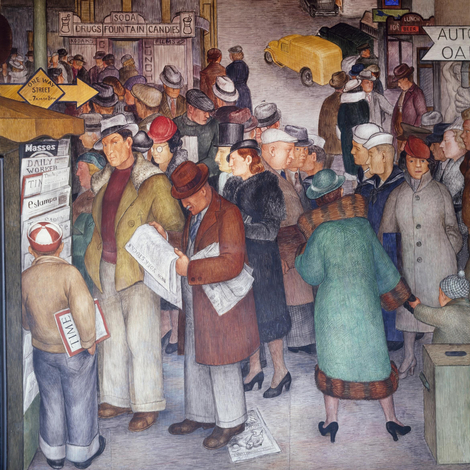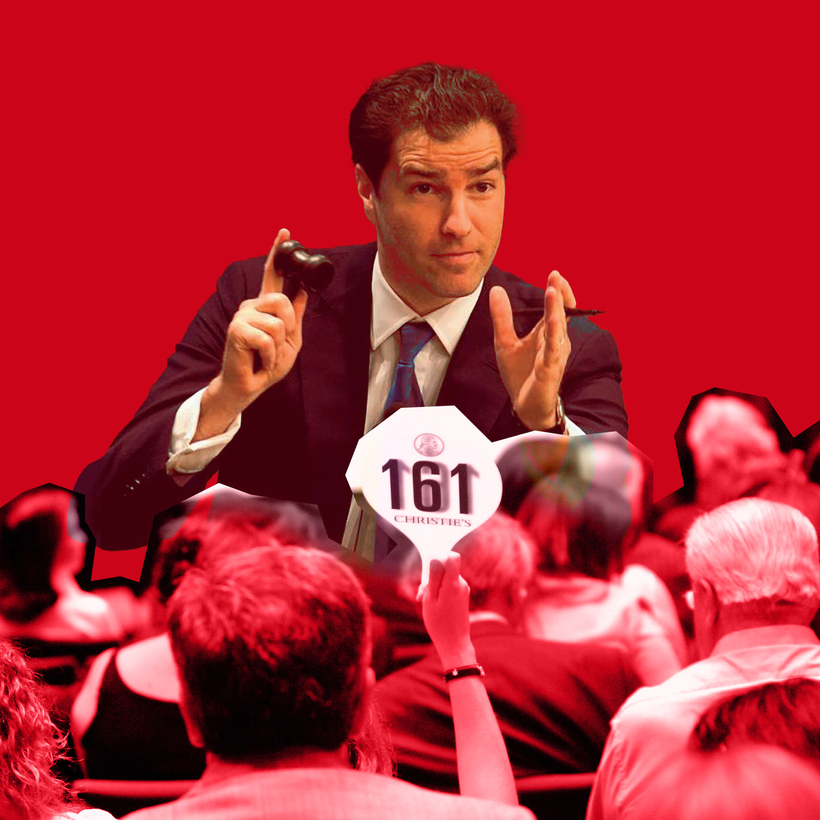Although there is something of the manor in Adrien Meyer, he was, rather, to the rostrum born. Meyer got the urge to be an art auctioneer at age eight, when, while growing up in Paris’s affluent Seventh Arrondissement (“not far from the Musée d’Orsay”), he went with his father, a banker, to the sales conducted at the venerable Hôtel Drouot. He instantly became intrigued by the man who waved a wooden hammer but ruled the room with sheer force of charm and a curious knack for getting people to raise their hands.
“I was hooked by this mysterious, very different world—I never thought for another moment about doing anything else,” Meyer told me one winter morning while sipping tea in a V.I.P. “skybox” overlooking the softly lit auction room at Christie’s in Rockefeller Center, his professional home since 2014.
Meyer didn’t just land his childhood dream job; he became a star. On the gray Thursday we chatted, he had already presided over the sale of 40 American masterworks for a total of $6.8 million and still had an hour to kill before lunch. If this year is anything like the last for the 259-year-old auction house, and it should be, he will personally sell—“knock down,” as they say in the business—more than $2 billion in studio art, letters, miscellaneous objects, and collections of such pre-owned luxury items as guitars, cars, and handbags.
No one who has seen him in auction action—winking, half smiling, making eye contact with a freshly Frédéric-Fekkai-ed matron in the 11th row, pausing, and then … raising an eyebrow and holding his pose until someone ups the ante by $10,000 (but never trying to goose the energy with some cheesy sales pitch)—has ever expressed bafflement about his success. “Central casting” is a phrase that comes up often when art folks hear his name, as is “comfortable in his own skin.” “He’s intensely curious about his world, always eager to engage,” Victoria Shaw, a well-known appraiser, told me. “He’s the absolutely perfect person for his job.”
So, wait—is this that rare French fairy tale with an unambiguously happy dénouement? One hopes so, for Meyer’s sake, but his career has already seen a few plot twists. Indeed, the changes in the business since Meyer, 47, studied contemporary art at the École du Louvre have been fairly seismic. “Everything in my business has become about creating friendships and fostering relationships,” says Meyer.
Wasn’t it always? Yes, but in the old days the auction houses focused their attention on a different set of players: the dealers, who would buy at something like wholesale prices and then tack on a premium before reselling to their collector clients. Partly to keep the latter at a distance, so they would be hazy about the extent of future markups, auction catalogues tended to be sketchy and obscure. They might have said, “Lot 22, a drawing” or “A drawing, possibly 17th century” and nothing else; the artist might not even have been mentioned, and there would have likely been no photographs, except on the cover. If you knew, you knew. If you didn’t, you might be confused or put off by the clubby atmosphere, but what could you do?
“It was not democratic,” Meyer says, and because the potential for further profit always had to be built into the bids, “we were not fulfilling our goal of getting the seller the highest price.”
What changed this system was not the shifting arc of the moral universe but the advent of digitalization. Once the complete sales history of an item could be called up with a few keystrokes, anyone could find its approximate true value and bid accordingly. Suddenly middlemen were less relevant, and auctions became more of a conversation between the houses and what Meyer calls “the end users of art” (or their personal advisers).
For Christie’s, Sotheby’s, and similar places, this newfound connection with the retail customer also showed that there was no need to cede even the private-sales side of the resale market to dealers. Meyer’s title since 2019 has been chairman of global private sales, and most of his time now is spent trying to convince people to think seriously about parting ways with a particular piece of art, or an entire collection. If he feels he can identify a buyer who might pay a premium to make a more discreet purchase, he will first advise pursuing a private sale, and if that doesn’t work out, he’ll suggest going the auction route.
Just don’t call it “the traditional auction route,” because the ritual bears only superficial resemblance to what Meyer fell in love with as a child. “The whole business today is not about what happens on the day of the bidding,” an art consultant told me. “It’s about ferreting out the amazing shit beforehand and making sure you get it and put it up for sale and the other guy doesn’t.” (For people at Christie’s, the “other guy” is almost always Sotheby’s; the houses are intensively competitive. “It’s Spy vs. Spy,” one consultant told me.)
Meyer, in his less coarse way, agrees that creating demand has become less urgent than stimulating supply—usually by conducting a subtle and protracted campaign of moving precious things out of rich people’s homes and into Christie’s. “Once you have something worthwhile it sells semi-automatically,” he says. “The real name of the game is to fill in your sale.”
While you can try to make nice to potential consigners by offering to do inventories and appraisals, by batting your eyes and asking to hear more about their philosophy of collecting, convincing people to let go of art can take years, or even decades. “Because you’re building trust, you must go slowly,” Meyer says. “I sometimes talk to people who haven’t even really started with their collections yet.” The upshot is that the schmooze-fest, for him, never stops.

There’s no mystery about why Meyer’s world has shifted, tipping him away from the auction room and causing him to go from lunches to chats to walks in the park to art-fair visits to golf and theater outings to … “Would you take a fishing trip with someone who owned a nice picture?,” I asked him. “Yes! Fishing, no problem!” he immediately says.
The art market has weakened in the last several years, as sanctions and economic downturns have taken out the Russians and Chinese, respectively, and some hedge-fund bros became disenchanted with the investment potential of contemporary art. Christie’s was down 6 percent year-over-year in 2024, while Sotheby’s was off 24 percent. When the action slows like that, collectors naturally take a wait-and-see approach, and that hesitancy only compounds the problem of scarcity.
Can the momentum be reversed? Meyer says he is generally optimistic, because the art market is usually “only a half-step away” from mirroring the American economy which, aside from a tariff wobble, has been strong of late. Meanwhile he intends to keep focusing on the supply shortage, pulling in what items and collections he can while embracing his new reality. It is “a job that is so special” because it involves three things he says he loves: people, art, and the art of persuading people to take action around art.
If there is any hint of a dark cloud behind his debonair mien, it is when he talks about what’s happened to auctions. Although they’ve been around at least since Babylonian brokers put prospective brides on the block, public sales of art these days aren’t just different; they’re decidedly less fun. “The room you saw this morning was O.K.,” Meyer told me, “but 30 years ago things were much more lively because you didn’t have the buyers on the phones, you didn’t have the online bidding, so everything was happening in the same place.”
It’s also true that when dealers were driving the prices, they operated more on gut instinct and educated guesses than today’s Internet researchers, which made outcomes less predictable and allowed the auctioneer to work his magic. Or fail to. The suspense, the elation, the disappointment in an auction room back then could be palpable, a combination of theater, sports, and reality TV. “I have to admit,” Meyer says, “it’s true that we have lost some of our soul.”
As he looks forward to the major May sales, Meyer says he is mindful of “a big mandate that we have to make sure that the auctions remain as inviting as possible and we don’t end up with an empty room where everything is virtual.”
Sweating the small stuff, he believes, can make a big difference. Christie’s now has a cozy café on its first floor to attract customers, and Meyer and his colleagues take care to greet people who turn up in person to bid or to just observe the action, the way he and his father once did. And while there is only so much extra money that even he can wring from a room in 2025, Meyer understands that numbers alone don’t shape the experience of his audience. Even if everyone already knows that a particular item should sell for $7 million, or $3,700, it is always within his power to turn a foregone conclusion into an aesthetic success, to make the transactional transcendent.
For the price of admission, which is free, he will push craft toward art in ways that he can enumerate and teach—little jokes, tone of voice, control of the pace—as well as in other, ineffable ways that come down to him being him, and thus are impossible to articulate. “The most important thing for me is to remain myself, to be authentic, so the people I’m talking to can see the human being behind the role of the auctioneer, and we can connect.” In the end, isn’t that what art is all about?
Charles Leerhsen is a former executive editor at Sports Illustrated and the author of several books, including Ty Cobb: A Terrible Beauty. His most recent book, Down and Out in Paradise: The Life of Anthony Bourdain, was published by Simon & Schuster

